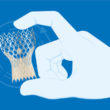Eberhard Grube2014-10-30 MD, FACC, FSCAIUniversity Hospital, Dept of Medicine II, Bonn, GermanyStanford University, Palo Alto, California, USA
REPRISE II: LOTUS valve for percutaneous aortic valve replacement
The aim of this study was to evaluate the safety and efficacy of the new device in patients with severe aortic stenosis at high surgical risk. We included 120 patients with a mean age of 84 years and the aortic valve area of 0.7 cm2. The device was successfully implanted in all patients with a...
The FDA Approves a Third Device in the TAVR Race
The Portico self-expanding graft has obtained FDA approval and can now compete as one of the three options available in clinical practice for transcatheter aortic valve replacement (TAVR) in the United States. For the time being, its indication will have some restrictions: for example, it can only be used in high-risk patients (unlike CoreValve and...
Convalescent Plasma for Severe Pneumonia from COVID-19
After testing multiple drugs and drug combinations in COVID-19 patients, only Remdesivir – for hospitalized patients – and dexamethasone – in patients requiring Oxygen – have shown some benefits. Convalescent plasma has been used for years assuming passive immunization might help control the infection until a specific immune response is established in the infected person....
The Transradial Approach Continues to Be the Best for Primary PCI
The transradial approach has been associated to lower mortality and bleeding rates in patients receiving primary PCI for ST elevation MI. This had been called into question by the recent SAFARI-STEMI, but after including its outcomes in a new meta-analysis, the scales tilted slightly in favor of the transradial approach vs. the transfemoral. The transradial...
The Most Read Scientific Articles in Interventional Cardiology
1- Long-Term Foramen Ovale Closure after Cryptogenic Stroke Patent foramen ovale closure is the standard treatment for cryptogenic stroke patients. However, there are is little information on its long-term evolution. Read more 2- Descending Thoracic Aortic Aneurysms: Is There a New Plan A? The last available evidence suggests that open surgery should be the...
Angiography Guided CABG Still Adequate
Fractional Flow reserve (FFR) guided myocardial revascularization surgery (CABG) has similar graft failure rate and clinical outcomes as angiography guided CABG. When planning PCI, the value of FFR for lesion assessment pose no questions, but we know little when it comes to CABG. Since the early start, back when Dr. Mason Sones performed catheterizations and...
Debris Captured by SENTINEL Devices Result Different across Different Valves
The idea behind this study is that debris can be captured in all patients during TAVR, even though we still ignore which patients would benefit more from this device. Tissue particles captured by the SENTINEL during TAVR vary from valve to valve, according to this new analysis. There are differences in size and number of...
Differences in Debris Captured According to Valve Type
During valve replacement, cerebral protection systems may capture debris in up to 99% of all patients. In over half of them, these particles are >1 mm. The particles captured during procedures in which Evolut R or Lotus valves were used were more and larger compared with those captured with the Sapien balloon-expandable valve. Beyond differences among valves,...
Bicuspid Valves Do Not Increase Mortality in TAVR
The frequency of bicuspid aortic valves (BcAV) are around 1%, but in 60+ patients it is associated to severe aortic stenosis. Even though surgery is the standard treatment, TAVR is the “off label” indication in high risk patients. BcAV presents differences with tricuspids given that it is more elliptic, has asymmetric calcification and more...









